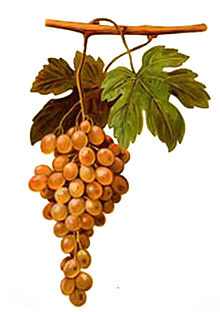Pedro Ximénez
| Pedro Ximénez | |
|---|---|
| Grape (Vitis) | |

Pedro Ximénez in Viala & Vermorel
|
|
| Color of berry skin | Blanc |
| Species | Vitis vinifera |
| Also called | PX, Pedro Jiménez, (more) |
| Origin | Spain |
| Notable regions | Jerez, Australia, Chile, |
| Notable wines | Pedro Ximénez |
Pedro Ximénez (also known as PX and many other variations) is the name of a white Spanish wine grape variety grown in several Spanish wine regions but most notably in the Denominación de Origen (DO) of Montilla-Moriles. Here it is used to produce a varietal wine, an intensely sweet, dark, dessert sherry. It is made by drying the grapes under the hot sun, concentrating the sweetness (similar to straw wine production), which are then used to create a thick, black liquid with a strong taste of raisins and molasses that is fortified and aged in solera.
Historically Pedro Ximénez is grown in Australia to make fortified wines and sherry type wines known by the Australian term - Apera. It is often used for blending and to make botrytised dessert wines and still lends itself in the Swan Valley to the making of dessert wine today. This grape variety has thrived in Western Australia's Swan Valley since its introduction there due to the hot climate growing conditions. The vine requires a rich soil and short pruning.James Busby brought some Pedro Ximénez to Australia in 1832. Some were imported from Jerez and planted at Clarendon; a transfer from the Sydney Botanic Garden is recorded in around 1839.
Pedro Giménez (Pedro Jiménez) is a widely grown criolla variety in South America whose relationship to Pedro Ximénez is uncertain, as it shows ampelographic differences.
There have been several apocryphal legends about the grape's origins. In 1661, the German ampelographer F. J. Sachs, speculated that Pedro Ximénez originated in either the Canary Islands or Madeira and was later brought to the German wine regions of the Rheingau, Rheinhessen and eventually the Mosel before either a Spanish soldier named Pedro Ximen or a Catholic Cardinal named Ximenès brought the grape to Málaga and Sierras de Málaga. This theory, which was spread in various incarnations by other German wine writers such as Baron August Wilhelm von Babo and Balthasar Sprenger, also led to speculation that Pedro Ximénez was somehow related (or possibly even the same grape) as the German wine grapes Elbling and Riesling but DNA evidence in the late 20th and early 21st century has discounted those theories.
...
Wikipedia
